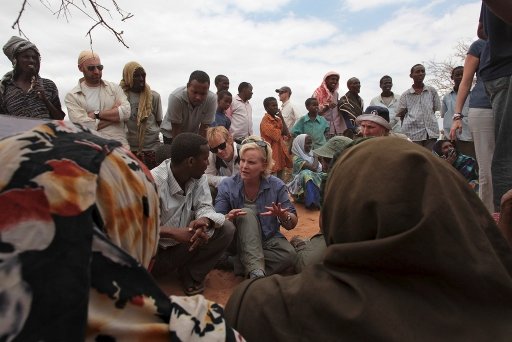15 days. This is the average amount of time that it has taken Somali refugees to walk from conflict- and drought-ravaged Somalia to the Dadaab refugee camp in north-eastern Kenya.
Dadaab, located approximately 100 km from the Kenya-Somalia border, is the largest refugee camp in the world, growing at approximately 1,200 people per day. The camp is so overcrowded that thousands wait ‘in-limbo’ outside its fence while more arrive each minute. Some are close to death by the time they arrive.
I was in Dadaab camp last week with a high level delegation from the US that included Cindy McCain, NBA legend Dikembe Mutombo and musician K’naan. They had travelled to Kenya to see firsthand the devastating effects of the food crisis and famine that is endangering millions of lives throughout the Horn of Africa.
We had to the opportunity to talk to many families at the camp. We heard harrowing and devastating stories of survival and resilience – stories of bandit attacks and of lost family members who just couldn’t take one more step. Most of the people there have walked hundreds of kilometers through a harsh, unforgiving climate.
The Horn of Africa crisis is one of the worst droughts in 60 years, affecting over 12 million people – mostly nomadic pastoralists and farmers from south central Somalia, north-eastern Kenya and south-eastern Ethiopia. The crisis has led to a major fund-raising campaign in Kenya. Within three days of launching, the ‘Kenyans for Kenya Initiative’ initiative had raised over 20 million Kenyan Shillings – approx. £150,000. The long-term goal is to raise 500 million Shillings.
Kenyan companies have made generous donations, but some of the real heroes have been ordinary Kenyans, who have been able to donate small amounts – from as little as 10 Shillings – via mobile phone.
While there is obviously a need to focus on the immediate imperative of saving lives, we must also focus on the future and longer-term investments and initiatives that are necessary to deliver food security. This is a complex problem of that cuts across a wide number of factors, including infrastructure, governance, market access and education.
On the second day of the trip, the team visited the Johanna Justin-Jinich Community Clinic, a health centre in Kibera, Africa’s largest slum, which provides high quality health care to those who need it the most. The centre is supported by the Global Alliance for Improved Nutrition (GAIN) through Feed the Children (UK).
This visit allowed us to look at the food crisis through a different lens and to understand that it is not restricted to the arid and semi-arid lands. It is also affecting communities in informal urban settlements as a result of rapidly rising food prices. An increasing number of Kenyans are struggling to afford their daily sustenance.
The clinic, which opened on in November 2010, was the brainchild of Kennedy Odede, a resident of Kibera who, growing up as the oldest of eight children, saw his family and community stifled by devastating poverty—from which there seemed to be no escape. Determined to change this, Kennedy started what is now the largest community-run organisation in Kibera. Over 300 women and children are enrolled in the clinic, which provides a feeding programme for young children.
This visit was followed by an African Leaders Roundtable convened by USAID. Musicians, DJs and fashion designers joined with UN, NGO and corporate representatives to hold a frank discussion on African-led solutions to African problems. Dikembe Mutumbo, the NBA Global Ambassador, brought it all home for those in the room when he asked: “How is it that we can put a man on the moon, but we cannot solve this problem?”
On the last of day of the rip, I felt that the group had come full circle in its understanding of the problems and their solutions. We visited an AGRA (Alliance for a Green Revolution in Africa) supported project in Thika, a town 40km north of Nairobi. The focus of the project is the development and promotion of cassava, an important food security crop grown in the semi-arid areas of Eastern Kenya.
Pioneered by Dr. Joseph Kamau, the project aims to develop virus-resistant, fast growing and high yield varieties of the crop that can sustain the local communities and address long terms solutions to food security. The pride and the beaming smiles of the small-scale farmers who showed us the variety of foodstuffs they had made from this one crop was clear evidence of what can be achieved when the right knowledge and resources are brought together.
Kenyans for Kenya, Kennedy and Dr Kamau are shining examples of African solutions for African problems. Each is having a significant impact. If there is one positive element to the current crisis, perhaps it is the spotlight that it is shining on the fact that Africa does have homegrown solutions to its challenges.
We need more of these, however. Then, in the future, we may not have to hear stories of families and individuals trekking for 15 days across inhospitable terrain to seek refuge.

